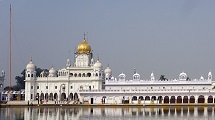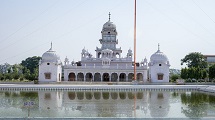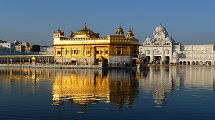Amritsar is a city famed for its heritage, history, culture, religion and beliefs, but most importantly for re-defining the true colors of India. There are many intriguing places to visit in Amritsar. Historically known as Ramdaspur, Amritsar is the Golden City in Punjab, a northwestern state in India. The city is located on the banks of Beas River and is home to one of the seven wonders of India – The Golden Temple. The city rejoices in the beliefs and culture of the Sikh religion and is therefore called Guru ki Nagari after the Sikh guru, Guru Ram Das, who founded this city.
Sharing its borders with Pakistan, Amritsar attracts a huge crowd of tourists every year from within India and Pakistan. There are a lot of historic spots to visit in Amritsar. Apart from the Sikh ones, Amritsar is characterised by mosques, Hindu temples, churches, and much more. Golden Temple, Durgiana Hindu Temple, Khairuddin Mosque, etc. are amongst some of the most-visited tourist attractions in Amritsar. Another prominent characteristic of Amritsar is in its contribution to the national heritage, from the Jallianwala Bagh to the well known Wagah border, where tourists flock in daily to witness the flag lowering ceremony.
Amritsar is not just a city, it’s the emotion of India. Its nationality and cultural diversity with a blend of nature makes it a city to remember. Your visit would be incomplete without these must-see tourist attractions:
Aath-Saath Tirath
Amongst the various places to visit in Amritsar, Ath Sath Tirath is a popular waterfront Sikh temple. Ath Sath literally means “The shrine of 68 Pilgrimages.” The temple was constructed in the 16th century and was named so by the Sikh guru, Guru Arjan. Next to the Dukh Bhanjani Beri, around the pool of holy water in the Harmandir Sahib complex, a raised canopy marks the shrine of the 68 pilgrimages or the Ath Saath Tirath. The complex includes various other Sikh architectures. Believers say that bowing with devotion and a pure heart at this shrine will give you the piety (punya) of visiting 68 Holy Places.
India Gate, Amritsar
It can rightly be said that Punjab, especially Amritsar, is a Land of Martyrs. Punjab and its people, across genders, have valiantly fought many battles to uphold the pride of their nation. From the times of Alexander the Great, to the days of the Kargil war, Punjab has witnessed numerous sacrifices on its sacred soil. Thus, with a view of recognising the sacrifices of those who sacrificed their lives, the Honorable Chief Minister of Punjab Sardar Parkash Singh Badal inaugurated a memorial-cum-museum at Amritsar which is now known as the India Gate and echoes the military ethos of Naam, Naman, Nishan (Honour, Integrity, Flag).
Durgiana temple
Yet another striking tourist attraction in Amritsar is the Durgiana Temple. Located near the Lohgarh Gate, this Hindu temple holds a deep historic significance, the roots of which are embedded in the Ramayana. It is believed to be the place where Luv and Kush took the captured-horse challenge of the Ashvamedha yagna and where the grandson of the God of Sun, Iksvaku, performed numerous yagnas. Today, this temple attracts worshippers from across the country, who come to purify themselves before Goddess Durga, the presiding deity here, along with the deities of Goddess Lakshmi and Lord Vishnu. Thus, granting it the names of Durga Tirath and Lakshmi Narayan Mandir.
Maharaja Ranjit Singh garden
Amritsar is not just confined to religious places but also includes some marvelous historical spots as well. A guide through the city includes a trip to the famous public garden of Amritsar, the Maharaja Ranjit Singh garden. Also known as Ram Bagh, the garden was constructed by Maharaja Ranjit Singh, the king responsible for pioneering the Sikh Empire in Punjab. In the centre of the garden is the summer palace of the Maharaj, known as the Ram Bagh Mahal. The construction dates back to 1818. The garden houses its wonders in an area of 84 acres and is surrounded by 14 feet high walls.
St. Paul's church
In spite of a Sikh dominated religious origin, Amritsar has a multicultural base. Amongst one of the oldest churches in the country, is the St. Paul’s Church, which is a very popular place to visit in the city. The architecture of the church dates back to 1852, the year of its establishment. Even with the perils of time, the architecture is quite subtle and well-maintained, till date. The scenic beauty of the neighbouring areas gives it a picturesque effect. If you are looking for a peaceful getaway, this place in Amritsar is surely a go-to.
Amritsar entrance gate
Just like royalty is, the Golden City of Amritsar welcomes you with huge, golden gates. When you enter the city, it is more like entering the court of a palace than the roads of a city. There are 4 such gates installed in the city, one at each main entrance. These are located at Amritsar-Jalandhar road, Amritsar-Attari road, Amritsar-Batala road and Amritsar-Tarn Taran road. The design of the gates was proposed by the Guru Nanak Dev University, and resembles the domes of Harmandir Sahib which will definitely make you go ‘wow’, as you pass through them.
Param Pujya Mata Lal Devi Mandir
Amongst the various religious places to visit, this temple is unique in its assent. The main deity of this temple isn’t a god or a mythical character, rather it is a female holy person called Lal Devi. The most renowned belief associated with this temple is in its miraculous ability to help helpless couples conceive children. As for the architecture, the temple is a replica of sorts of the Vaishno Devi temple in Jammu and Kashmir. From within, the temple is a Sheesh Mahal (Palace of Mirrors), owing to the intricately designed mirror work inside it.
Gurdwara Baba Atal Rai Sahib Ji
On your tour to Amritsar, you are likely to visit this popular Sikh shrine. Situated to the south of Golden Temple, the Gurdwara stands nine storey high, in an octagonal tower. It was originally the Samadhi of Baba Atal Rai, son of Guru Hargobind. At the age of 9 years, Baba Atal Rai restored the life of his close friend, after his sudden demise. This act was considered against the Sikh tradition by Guru Hargobind, leading Baba Atal Rai into a meditative trance where he breathed his last. The 9 stories of the Gurdwara reflect the nine years of his life.
Khairuddin mosque
This mosque does not only hold a religious significance but also historic significance in the freedom struggle of India. The Khairuddin Mosque was built in 1876 by Muhammad Khairuddin. Shah Attaullah Bukhari, the then Tootie-e-Hind, had called upon the people together, to wage war against the British colonists. It was at this very place where the fire of freedom was instigated. Apart from historic significance, the mosque is visited by believers in huge numbers who come here with the expectation of finding answers to their prayers. The architecture of the mosque too is fascinating and a view to behold.
Heritage walk and Golden Temple tour
The city of Amritsar is most prominently known for its cultural heritage. The most popular spot is obviously the Golden Temple. A tour of this unique symbol of purity is something you cannot miss on a trip to Amritsar. Located in the Harmandir Sahib Complex, the Gurudwara is built at a level below the near ground level. The unique architecture is the shrine is quite welcoming to everyone. Another striking thing to do in Amritsar is take part in the Heritage walk. This is a guided tour within the lanes of Amritsar that will take you back in time.
Gurudwara Guru ka mahal
Another heritage spot within the Harmandir Sahib Complex is the Gurudwara Guru ka mahal. Originally built as a small hut, this place was later transformed into a Gurdwara. This place was the home to Guru Ram Das and his family, who founded the city of Amritsar by excavation of the pool of holy nectar. Guru Arjan Dev and Guru Hargobind were also married here. This place is also the birthplace of Baba Atal Rai and Guru Teg Bahadur. Their birthdays are celebrated as a festival here, for which the Gurdwara witnesses a special Guru Ka Langar on the first Sunday of Bikrami month.
Gandhi gate
Gandhi Gate is a gate made in red sandstone that stands at the main entrance to the old city of Amritsar. Earlier known as the Hall Gate, the gate stood intact since the 1700s and was renamed Gandhi Gate after independence. Across the gate you will find a bustling market. The place is a haven for shopping lovers. The market attracts you with beautiful ethnic attire, Punjabi wear, delicious local cuisine and many more things. If you have a penchant for street food and shopping, this place is meant just for you.
Darshani Deori
The main entrance to the Harmandir Sahib Complex is known as Darshani Deori. This gate is ornately built with marble and fresco work. It was constructed during the rule of Maharaja Ranjit Singh. One side of the Deori is decorated with silver sheets while the other side has a beautiful layout of ivory work. Devotees gather in front of the Deori every morning and participate in the recitation of the Shabads. The Deori consists of a room on one side for Akhand Path and another one for the palanquin. Later, at night, devotees take turns cleaning the sanctorum.
Valmiki Tirath Sthal
Another popular place to visit is the Bhagwan Valmiki Tirath Sthal. This temple is an important religious monument of the Hindus, and is believed to be the birthplace of Luv and Kush, the sons of Lord Ram and Sita Mata. Located 11 km from the city, the temple is also famously known as the Ashram of Sage Valmiki, and therefore gets its name. This was the very place where Sita Mata was sheltered after her retreat from Lanka. Also, this is the place where the Ramayana was written by Rishi Valmiki. Thus, it is also called Ram Tirath.
Beri Baba Budha Ji
This historic marvel is basically a Beri tree located within the Harmandir Sahib complex. This tree is associated with Baba Budha Ji who was sheltered beneath this tree during the time when he was digging the holy tank of Harmandir Sahib, in the excavation of the holy waters. Baba Budha was originally known as Bura and was given the title of Budha, for his wisdom beyond his age, by Guru Nanak Sahib. He was also the first Granthi (Granth Reciter) appointed by Guru Arjan Sahib in 1600s. Today this tree is a worship place for believers, who come here to pay tribute to Baba Budha Ji.
Martyr's well
Amritsar is also infamous for the 1919 Jallianwala Bagh Massacre in which Acting Brigadier-General Reginald Dyer and his troops blocked all the entrances of this public garden. They opened fire at the crowd of Sikh locals who had gathered there to celebrate Baisakhi and silently protest the arrest of their national leaders. The continuous fire killed about 400 men and women. Uncertain folks rushed to save their lives and many of them jumped into a well within the Bagh, to escape the open attack. This well is today preserved as the Martyr’s Well and commemorates the ruthless killing of the innocents by the Britishers that shook the entire country.
Ramgarhia Bunga
Ramgarhia Bunga is a famous place to visit in Amritsar. These are 2 tall minarets located near Golden Temple and can be seen from the Parikrama of the Harmandir Sahib Complex. During the Mughal reign, the Golden Temple and other such Sikh shrines were attacked regularly. Owing to this, 12 Sikh Misls along with some Khalsa leaders were housed in 70 Bungas built in the region surrounding the Golden Temple. Later, these were used for the accommodation of Sikh pilgrims. However, most of the Bungas were demolished during the British Rule leaving Ramgarhia Bunga and Akal Takht as the two remains of this architecture.
Santokhsar Sahib
This place of Sikh sarovar was constructed by Sikh guru, Guru Arjun Dev and is a popular tourist destination in Amritsar. Located about 700 metres away from Harmandir Sahib, this is the place where Guru Ram Das, on instructions from Guru Amar Das, carried out the excavation of a holy tank only to find a sage meditating in the tank. The sage named Santakha breathed his last after achieving salvation from the Guru and thus, the place came to be known as Santokhsar Sahib. Every year believers visit this unique place in anticipation of salvation, just like the sage.
FAQ
Throughout the year, what is the best time to visit Amritsar?
Amritsar remains a dry and warm city throughout the year. However, the winter months from November to March are more suitable to visit the city and you’ll enjoy it.
What kind of attire is needed to travel to Amritsar?
Amritsar is a religious city. Therefore, it is advised to carry modest attire and a couple of scarves to cover your head, while visiting religious places in Amritsar.
Is the domestic flight schedule on time?
The flight schedule for domestic flights is usually on time. Amritsar has an international airport, the Shri Guru Ram Dass Jee International Airport. Being an international airport, almost all flights are on time.
What are the major festivals celebrated in Amritsar?
You can witness a plethora of festive vibes in Amritsar during Lohri, Guru Purab, Ram Tirath Fair, Basant Panchami, Baisakhi, etc. So try to plan your trip to Amritsar during this time.
How is the food in Amritsar?
Typical Punjabi food is quite spicy and strong in flavours. It is known for a literal explosion in your mouth once you taste it. Do not miss visiting the dhabas in Amritsar. However, if you have a preference for subtle flavors, you may get variants at restaurants.
What are some less-frequented Amritsar tourist places?
Apart from the various tourist spots to visit in Amritsar, there are some lesser-known yet important tourist attractions one can visit. These include the Gobindgarh Fort, Pul Kanjari, Thakurdwara Dariana Mal, etc.









